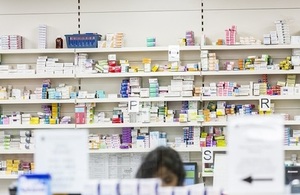Antimicrobial resistance: UK launches 5-year action plan and 20-year vision
The plans outline the UK's contribution to containing and controlling antimicrobial resistance (AMR) in health, animals, the environment and the food chain.

Prescription medications on pharmacy shelves.
The government has published a 20-year vision and 5-year national action plan for how the UK will contribute to containing and controlling AMR by 2040.
The plans include targets, such as:
- cutting the number of drug-resistant infections by 10% (5,000 infections) by 2025
- reducing the use of antibiotics in humans by 15%
- preventing at least 15,000 patients from contracting infections as a result of their healthcare each year by 2024
A major focus of the plan is to make sure current antibiotics stay effective by reducing the number of resistant infections and supporting clinicians to prescribe appropriately.
New technology will also be used to gather real-time patient data, helping clinicians understand when to use and preserve antibiotics in their treatment. This could be followed and adapted all over the world, building the database on antibiotic use and resistance.
The plans cover animals and the environment as well as human health. The government has committed to working with vets and farmers to further reduce antibiotic use in animals by 25% between 2016 and 2020, with objectives to be refreshed by 2021.
The pharmaceutical industry will also be expected to take more responsibility for antibiotic resistance. NICE and NHS England will explore a new payment model that pays pharmaceutical companies based on how valuable their medicines are to the NHS, rather than on the quantity of antibiotics sold.
Antibiotic resistance is predicted to kill 10 million people every year by 2050 without action, as outlined in the independent review on antimicrobial resistance. Without effective antibiotics, straightforward, everyday operations like caesarean sections or hip replacements could become too dangerous to perform.
Since 2014, the UK has cut the amount of antibiotics it uses by more than 7% and sales of antibiotics for use in food-producing animals have dropped by 40%. But the number of drug-resistant bloodstream infections have increased by 35% from 2013 to 2017.
The national action plan and 20-year vision were developed in close collaboration with the devolved UK administrations.
Health and Social Care Secretary Matt Hancock said:
Imagine a world without antibiotics. Where treatable infections become untreatable, where routine surgery like a hip operation becomes too risky to carry out, and where every wound is potentially life-threatening. What would go through your mind if your child cut their finger and you knew there was no antibiotic left that could treat an infection? This was the human condition until almost a century ago. I don’t want it to be the future for my children – yet it may be unless we act.
As Health Secretary, responsible for one of the most advanced healthcare systems in the world, I could not look my children in the eyes unless I knew I was doing all in my power to solve this great threat. When we have time to act. But the urgency is now.
Each and every one of us benefits from antibiotics, but we all too easily take them for granted, and I shudder at the thought of a world in which their power is diminished. Antimicrobial resistance is as big a danger to humanity as climate change or warfare. That’s why we need an urgent global response.
Prime Minister Theresa May said:
The increase in antibiotic resistance is a threat we cannot afford to ignore. It is vital that we tackle the spread of drug-resistant infections before routine operations and minor illnesses become life-threatening.
I am very proud of the UK’s global leadership on this important agenda. We will continue to work with our partners to drive international action that will protect the health of future generations.